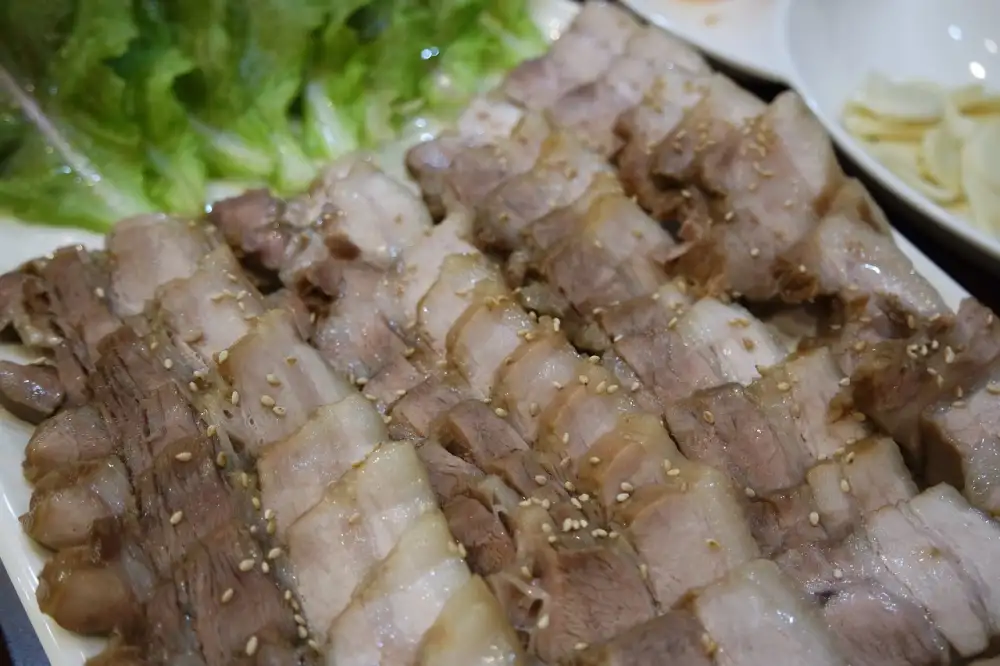Discover the Savory Delights of Korean Beef: Uncover Recipes and Tips for Perfectly Cooked Bulgogi and Galbi

Korean beef, also known as hanwoo, is renowned for its exceptional quality and flavor. It is a staple in Korean cuisine and has gained popularity worldwide for its unique taste and tenderness. This article will take you on a culinary journey through the artistry of Korean beef, exploring its history, different cuts, traditional recipes, modern fusion dishes, cooking tips, where to find authentic Korean beef, health benefits, and pairing it with delicious Korean side dishes. Get ready to embark on a savory adventure as we uncover the secrets of perfectly cooked bulgogi and galbi!
History and Significance of Korean Beef
Korean beef, known as Hanwoo, has a rich history and holds great significance in Korean culture. The tradition of raising cattle in Korea dates back over 2,000 years. During the Joseon Dynasty, beef was considered a luxury food reserved for the nobility and royalty. It symbolized wealth and prosperity.
In the past, cattle were primarily used for farming purposes rather than for meat consumption. However, with advancements in agriculture and breeding techniques, the focus shifted towards producing high-quality beef. Today, Hanwoo is renowned for its exceptional taste and tenderness.
The significance of Korean beef goes beyond its culinary value. It represents the pride and identity of the Korean people. The government has implemented strict regulations to protect and promote Hanwoo as a national treasure. This includes maintaining breed purity and providing support to farmers who raise Hanwoo cattle.
Korean beef has gained international recognition for its superior quality and flavor profile. It is often compared to other premium beef varieties like Kobe or Wagyu. The unique climate, geography, and feeding methods contribute to the distinct taste of Hanwoo.
Whether enjoyed in traditional dishes or modern fusion recipes, Korean beef continues to captivate food enthusiasts around the world. Its history and cultural significance make it an integral part of Korean cuisine that should be celebrated and savored by all who appreciate the artistry of food.
Different Cuts of Korean Beef
Korean beef offers a wide variety of cuts that cater to different tastes and cooking methods. The most popular cuts include bulgogi and galbi. Bulgogi is thinly sliced beef, usually from the tenderloin or sirloin, marinated in a savory blend of soy sauce, garlic, sesame oil, and sugar. Galbi, on the other hand, refers to beef short ribs that are marinated in a sweet and savory sauce before being grilled or braised. Other cuts such as brisket, ribeye, and flank steak are also commonly used in Korean cuisine. Each cut offers its own unique texture and flavor profile, making Korean beef a versatile choice for any culinary adventure.
Traditional Korean Beef Recipes
Korean cuisine is known for its bold flavors and unique cooking techniques, and traditional Korean beef recipes are no exception. Two popular dishes that showcase the savory delights of Korean beef are Bulgogi and Galbi.
Bulgogi, which translates to "fire meat," is thinly sliced beef marinated in a mixture of soy sauce, sesame oil, garlic, sugar, and other seasonings. The marinated beef is then grilled or pan-fried until tender and caramelized. The result is a mouthwatering dish with a perfect balance of sweet and savory flavors.
Galbi, on the other hand, refers to beef short ribs that are marinated in a similar sauce as Bulgogi but with the addition of pear puree or juice. This marinade helps to tenderize the meat and adds a subtle sweetness. The marinated ribs are then grilled or broiled to perfection, resulting in succulent and flavorful meat that falls off the bone.
Both Bulgogi and Galbi can be enjoyed on their own or wrapped in lettuce leaves along with rice and various condiments like kimchi or ssamjang (a spicy dipping sauce). These dishes are often served at special occasions or family gatherings, showcasing the importance of food in Korean culture.
By exploring these traditional Korean beef recipes, you can experience the rich flavors and culinary artistry that make Korean cuisine so unique.
Modern Fusion Recipes with Korean Beef
In recent years, Korean cuisine has gained immense popularity worldwide, and chefs have been experimenting with new ways to incorporate the rich flavors of Korean beef into fusion dishes. These modern fusion recipes offer a unique twist on traditional Korean flavors, combining them with ingredients from other culinary traditions.
One popular fusion dish is Korean Beef Tacos. Tender marinated bulgogi beef is served in a warm tortilla, topped with fresh vegetables like shredded lettuce, diced tomatoes, and tangy kimchi. The combination of savory beef and vibrant toppings creates a mouthwatering explosion of flavors.
Another innovative fusion recipe is Korean Beef Bibimbap Bowl. This dish takes the concept of bibimbap, a traditional Korean rice bowl, and adds a modern twist by using thinly sliced galbi beef instead of the usual ground meat. The beef is cooked to perfection and placed on top of a bed of steamed rice along with an assortment of colorful vegetables and a fried egg. A drizzle of spicy gochujang sauce completes this delicious fusion creation.
For those who enjoy the bold flavors of Korean barbecue, another fusion option is Korean Beef Sliders. Miniature buns are filled with succulent grilled bulgogi beef patties and topped with melted cheese, pickles, and a dollop of spicy aioli sauce. These sliders are perfect for parties or as an appetizer for any occasion.
The beauty of modern fusion recipes lies in their ability to combine different culinary influences while still maintaining the essence of traditional Korean flavors. Whether it's tacos, bowls, or sliders, these creative dishes showcase the versatility and adaptability of Korean beef in today's global food scene.
By exploring these modern fusion recipes, you can elevate your culinary experience and discover new ways to enjoy the savory delights of Korean beef. So why not embark on a flavorful journey that combines the best of both worlds? Try out these innovative recipes at home and let your taste buds be amazed.
Tips for Cooking Korean Beef at Home
1. Marinating: To infuse the meat with flavor, marinate it for at least 2 hours or overnight. A traditional marinade includes soy sauce, sesame oil, garlic, ginger, and sugar.
2. Slicing: For bulgogi, slice the beef thinly against the grain to ensure tenderness. For galbi, cut across the bones to create individual ribs.
3. Grilling: Preheat the grill to medium-high heat and brush it with oil to prevent sticking. Cook bulgogi for 2-3 minutes per side and galbi for 4-5 minutes per side until nicely charred.
4. Stir-frying: Heat a wok or skillet over high heat and add a small amount of oil. Stir-fry the beef in batches for a few minutes until cooked through but still tender.
5. Resting: Allow the cooked beef to rest for a few minutes before serving to retain its juices and enhance its tenderness.
6. Garnishing: Sprinkle some toasted sesame seeds or sliced green onions on top of your dish for added flavor and visual appeal.
By following these tips, you can recreate the delicious flavors of Korean beef right in your own kitchen!
Where to Find Authentic Korean Beef
When it comes to finding authentic Korean beef, there are a few key places to consider. One option is to visit your local Korean grocery store or Asian market. These stores often carry a variety of cuts of Korean beef, including bulgogi and galbi. You can also ask the staff for recommendations on which cuts are best for specific recipes.
Another option is to look for Korean restaurants that specialize in Korean barbecue. These establishments typically source their beef from reputable suppliers that provide high-quality, authentic Korean beef. Not only will you be able to enjoy deliciously cooked Korean beef dishes, but you may also have the opportunity to try different cuts and cooking styles.
If you prefer the convenience of online shopping, there are several websites that offer authentic Korean beef for delivery. These online retailers work directly with farmers and suppliers in Korea to ensure the quality and authenticity of their products. Just make sure to read reviews and check the reputation of the website before making a purchase.
Lastly, if you're lucky enough to live near a Korean community or have access to local farmers' markets, you may be able to find locally sourced Korean beef. This can be a great way to support local businesses while enjoying the taste of authentic Korean cuisine.
No matter where you choose to find your Korean beef, it's important to do some research and ensure that the supplier or restaurant has a good reputation for providing high-quality, authentic products. By sourcing your ingredients from trusted sources, you can guarantee an exceptional dining experience filled with the savory delights of genuine Korean beef.
Health Benefits of Korean Beef
Korean beef not only tantalizes the taste buds but also offers numerous health benefits. Firstly, it is a rich source of protein, which is essential for muscle growth and repair. Additionally, Korean beef is known to contain high levels of essential amino acids that promote overall well-being. It is also a good source of vitamins and minerals such as iron, zinc, and vitamin B12, which are crucial for maintaining healthy blood cells and boosting energy levels. Moreover, Korean beef contains conjugated linoleic acid (CLA), a fatty acid that has been linked to weight loss and improved heart health. So, indulging in the savory delights of Korean beef not only satisfies your cravings but also contributes to your overall health and vitality.
Pairing Korean Beef with Korean Side Dishes
One of the joys of Korean cuisine is the art of banchan, or side dishes. These small plates are served alongside the main course and provide a variety of flavors and textures to complement the star of the show - Korean beef.
When it comes to pairing Korean beef with side dishes, there are a few classics that never fail. Kimchi, a spicy fermented cabbage, is a staple in Korean cuisine and adds a tangy kick to any meal. The combination of the rich, savory beef with the bold flavors of kimchi creates a harmonious balance on your palate.
Another popular side dish is japchae, a stir-fried noodle dish made with sweet potato noodles. The chewy texture of the noodles pairs perfectly with tender slices of beef, creating a delightful contrast in every bite.
For those who enjoy something lighter, kongnamul muchim is an excellent choice. This seasoned soybean sprout salad provides a refreshing crunch that complements the richness of the beef.
If you're looking for something more adventurous, consider adding bindaetteok, or mung bean pancakes, to your meal. These crispy pancakes filled with mung beans and vegetables add an extra layer of flavor and texture to your dining experience.
Don't forget about ssamjang! This flavorful dipping sauce made from fermented soybean paste and chili pepper paste is perfect for wrapping pieces of grilled beef in fresh lettuce leaves.
Pairing Korean beef with these traditional side dishes not only enhances the overall dining experience but also allows you to explore the depth and complexity of Korean flavors. So next time you cook up some bulgogi or galbi at home, don't forget to prepare some banchan to complete your culinary journey through Korea's rich food culture.
In conclusion, exploring the richness of Korean beef is a culinary journey that promises to delight your taste buds. From its historical significance to the various cuts and traditional recipes, Korean beef offers a unique and savory experience. Whether you prefer the classic flavors of bulgogi or the succulent tenderness of galbi, there are endless possibilities to explore with this versatile ingredient. Additionally, the fusion recipes showcase how Korean beef can be incorporated into modern dishes, adding a delicious twist to your meals. With these tips for cooking at home and knowledge of where to find authentic Korean beef, you can recreate these delectable flavors in your own kitchen. Not only does Korean beef offer incredible taste, but it also boasts health benefits that make it a nutritious choice. Finally, pairing Korean beef with traditional side dishes completes the dining experience and adds depth to every bite. So embark on this culinary adventure and discover the savory delights of Korean beef for yourself!
Published: 30. 11. 2023
Category: Food



